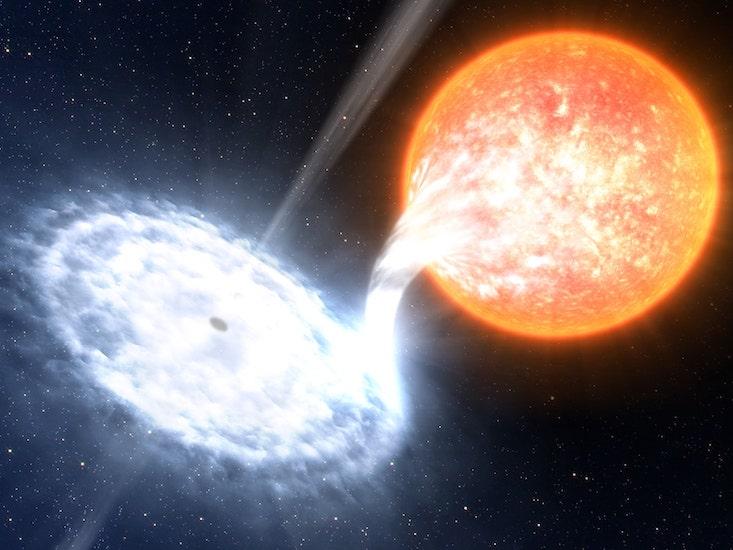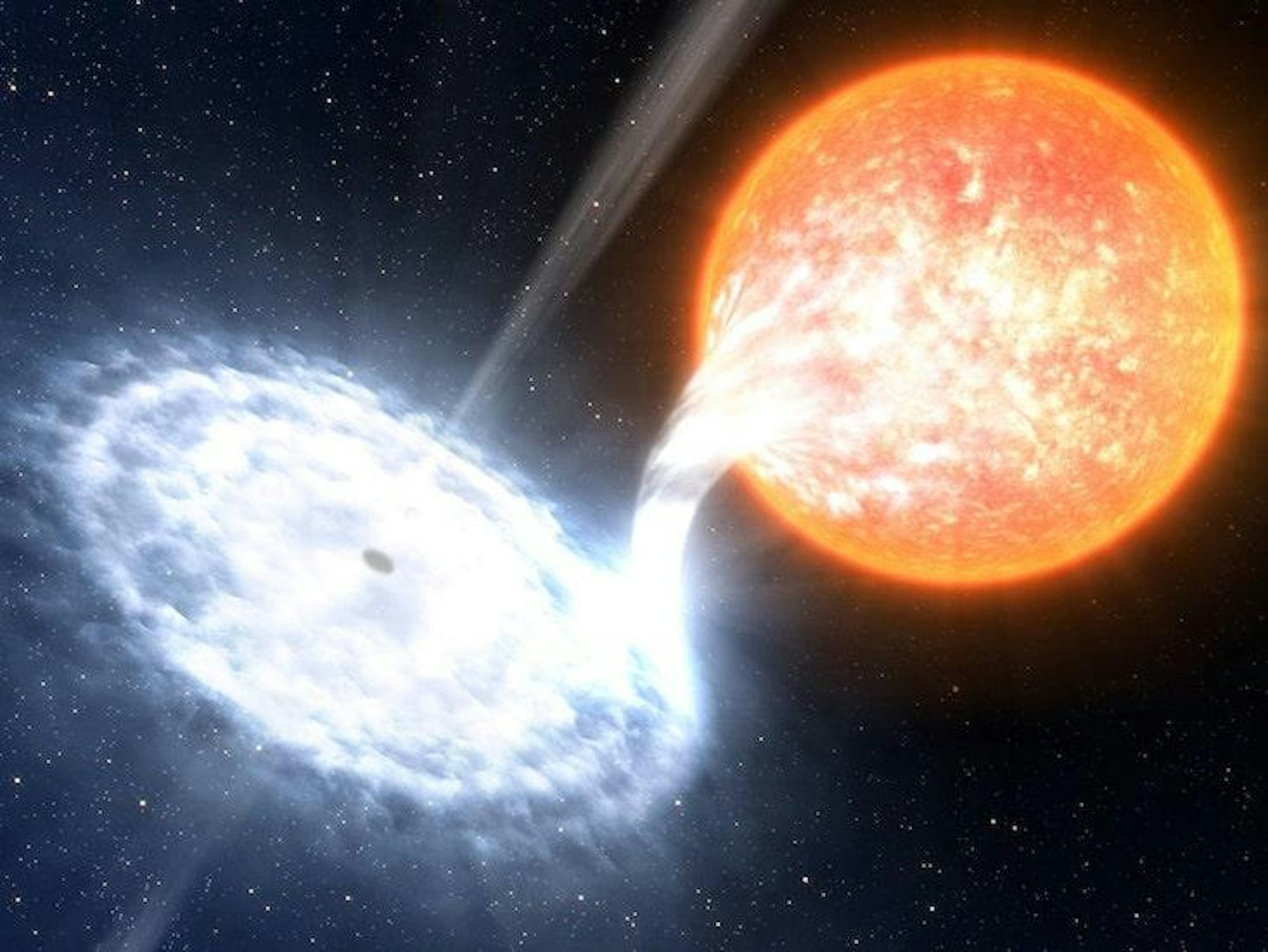
When I was 12, I made the mistake of watching the Paul W. S. Anderson horror film, Event Horizon. It gave me nightmares for weeks: The movie’s title refers to an experimental spaceship that could create artificial black holes through which to travel, making interstellar trips trivial. But the crew, upon activating the ship’s gravity drive, ended up somewhere like Hell. Possessed by what appears to be the ship itself—it seems to acquire a will of its own—they mutilated themselves and one another. A crew member had the presence of mind to broadcast a final message, amid the screams, to any would-be rescuers: liberatis me (“save me”). Black holes have held me in a state of trembling fascination ever since. I doubt they lead to some demonic dimension but, like the existence of God, such a realm can’t, strictly speaking, be disproven, only judged improbable.
I couldn’t put the possibility out of mind as I read Einstein’s Shadow: A Black Hole, a Band of Astronomers, and the Quest to See the Unseeable. The book, by science writer and editor Seth Fletcher, is about Sheperd Doeleman and the other scientists behind the Event Horizon Telescope, the goal of which was to photograph a black hole. Doeleman, Fletcher writes, thought his team “could cause a historical disjuncture—before the first picture of a black hole, and after.” A few months ago, they unveiled the picture of galaxy Messier 87’s central black hole, with gas—in hues of red, orange, and yellow—glowing around it. It was mesmerizing. It showed the shadow cast by the event horizon, confirming a prediction of Einstein’s theory of general relativity.
In May, in a conversation with Doeleman, Chris Anderson, of TED, asked, “Where do you end up if you fall into a black hole?” Being in Vancouver, Doeleman joked, “Vancouver. Here we are.” But then went on to call black holes “the central mystery of our age.” Why? “Because that’s where the quantum world and the gravitational world come together. What’s inside is a singularity, where all the forces become unified because gravity finally is strong enough to compete with all the other forces”—the strong, weak, and electromagnetic. But we can’t see the singularity. “The universe has cloaked it in the ultimate invisibility cloak. We don’t know what happens in there.”
And yet the mystery goes deeper: What might be more puzzling than the innards of a black hole is the trouble of defining one in the first place. That’s what Erik Curiel found out when he asked theoretical and experimental physicists, mathematicians, and philosophers, “What is a black hole?” Curiel, a physicist and philosopher himself, at the Munich Center for Mathematical Philosophy, reported on his experience chatting with these researchers in a Nature Astronomy paper, titled “The many definitions of a black hole.” One response in particular, he thought, from Beatrice Bonga, who specializes in gravitational waves at the Perimeter Institute, was emblematic of the rest. “Your five-word question is surprisingly difficult to answer,” she told him, “…and I definitely won’t be able to do that in five words.”
Isn’t a black hole just a region in space where matter has become so dense that not even light can escape its gravity? Simple? Well, no. That’s the layman’s way of expressing the effect of the event horizon, which was classically defined, Curiel says, as “the boundary of the causal past of future null infinity.” He explains that the definition “tries to take the intuition that a black hole is a ‘region of no escape’ and make it precise.” Curiel thought many of the folks he spoke to would bring this up, but most didn’t. Those who did mentioned it partly to point out its problems. Curiel writes:
This definition is global in a strong and straightforward sense: the idea that nothing can escape the interior of a black hole once it enters makes implicit reference to all future time—the thing can never escape no matter how long it tries. Thus, in order to know the location of the event horizon in spacetime, one must know the entire structure of the spacetime, from start to finish, so to speak, and all the way out to infinity. As a consequence, no local measurements one can make can ever determine the location of an event horizon. That feature is already objectionable to many physicists on philosophical grounds: one cannot operationalize an event horizon in any standard sense of the term. Another disturbing property of the event horizon, arising from its global nature, is that it is prescient. Where I locate the horizon today depends on what I throw in it tomorrow—which future-directed possible paths of particles and light rays can escape to infinity starting today depends on where the horizon will be tomorrow, and so that information must already be accounted for today. Physicists find this feature even more troubling.
Sean Gryb, a quantum gravity theorist at the Perimeter Institute, told Curiel, “The existence of [a classical event horizon] just doesn’t seem to be a verifiable hypothesis.”
Curiel spoke to some researchers who made black holes out to be even more exotic than I thought possible. For example, theoretical physicist Domenico Giulini, of Leibniz University Hannover, was skeptical that black holes were physical things at all. “It is tempting but conceptually problematic to think of black holes as objects in space, things that can move and be pushed around,” he said. “They are simply not quasi-localized lumps of any sort of ‘matter’ that occupies [spacetime] ‘points.’” But others, like Ramesh Narayan, at the Harvard-Smithsonian Center for Astrophysics, are less fanciful. “A black hole is a compact body of mass greater than four solar masses—the physicists have shown us there is nothing else it can be.”
Black holes, it cannot be denied, are both simple and complicated. For Chiara Mingarelli, a gravity-wave researcher, it’s those two qualities that make black holes so fascinating. “It’s this interesting duality of them being really simple and really complicated. So they’re really simple. You can describe them by their mass and their spin, right? But what’s past the event horizon? What does the singularity actually look like? Is it actually this point of infinite curvature? It is some sort of quark soup? What does it look like?” She imagines that, as light travels toward the singularity, in all sorts of wonderful orbits, there must be fireworks. “I try to imagine it as like a water fountain, having light coming out and then falling back in on itself as it approaches the event horizon.”
Catch the rest of Mingarelli’s interview with Nautilus here. She discusses her reaction to the detection of gravitational waves, how they compress space and time, and whether it is fair for only a few people to win the Nobel Prize for spotting them.
Brian Gallagher is an associate editor at Nautilus. Follow him on Twitter @bsgallagher.


























